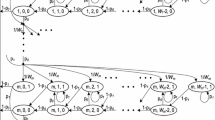Abstract
IEEE 802.11 point coordination function (PCF) protocol plays a fundamental and core role for other contention-free protocols such as IEEE 802.11e HCCA. In PCF, each station transmits at most one packet upon polled. Existing theoretical studies on PCF either reconstruct complicated queueing models that are not easily extended for heterogeneous traffic, or convert the PCF system into an exhaustive queueing system that are difficult to understand. This paper propose applying the classic pure limited queueing model for performance analysis to overcome existing methods’ drawbacks. The proposed model is naturally consistent with the semantics of the PCF protocol and therefore it is most easy to understand and simpler than existing models. The derived theoretical expressions are exactly same to the existing results that are already verified by extensive simulations.




Similar content being viewed by others
References
ANSI/IEEE Std 802.11 (R2003). Part 11: Wireless LAN medium access control (MAC) and physical layer (PHY) specifications.
Cai, L. X., Shen, X., Mark, J., Cai, L., & Xiao, Y. (2006). Voice capacity analysis of wlan with unbalanced traffic. IEEE Transaction on Vehicular Technology, 55(3), 752–761.
Cicconetti, C., Lenzini, L., Mingozzi, E., & Stea, G. (2005). A software architecture for simulating IEEE 802.11e HCCA. In: IPS-MoMe05 proceeding from the 3rd workshop on internet performance, simulation, monitoring and measurement, pp. 97–104.
Crow, B., Widjaja, I., Kim, J., & Sakai, P. (1997). Investigation of the IEEE 802.11 medium access control (MAC) sublayer functions. In: Proceedings of IEEE INFOCOM ’97, Vol. 1, pp. 126–133.
Feng, L., Li, J., & Lin, X. (2013). A new delay analysis for IEEE 802.11 PCF. IEEE Transactions on Vehicular Technology, 62(8), 4064–4069.
Hongwei, D., Dongfeng, Z., & Yifan, Z. (2010). Analysis of polling system with multiple vacations and using exhaustive service. In: Innovative computing communication, 2010 International conference on and information technology ocean engineering, 2010 Asia-Pacific conference on (CICC-ITOE), pp. 294–296.
Iyengar, R., & Sikdar, B. (2012). A queueing model for Polled service in WiMAX/IEEE 802.16 networks. IEEE Transactions on Communications, 60(7), 1777–1781.
Liu, Q., & Zhao, D. (2009). Analysis of two-level-polling system with mixed access policies. In: Intelligent computation technology and automation, (ICICTA ’09), pp. 357–360.
Siddique, M., & Kamruzzaman, J. (2010). Performance analysis of PCF based WLANs with imperfect channel and failure retries. In: IEEE Proceedings of GLOBECOM, pp. 1–6.
Sikdar, B. (2007). An analytic model for the delay in IEEE 802.11 PCF MAC-based wireless networks. IEEE Transactions on Wireless Communications, 6(4), 1542–1550.
Sikdar, B. (2009). Queueing analysis of Polled service classes in the IEEE 802.16 MAC protocol. IEEE Transactions on Wireless Communications, 8(12), 5767–5772.
Takagi, H. (1991). Queueing analysis: Volume 1. North-Holland Amsterdam.
Visser, M., & El Zarki, M. (1995). Voice and data transmission over an 802.11 wireless network. In: Proceedings of IEEE PIMRC 1995, pp. 648–652.
Wu, J., & Huang, G. (2010). Simulation study based on QoS schemes for IEEE 802.11. In: The 3rd international conference on advanced computer theory and engineering (ICACTE), pp. 534–538.
Yang, H., & Sikdar, B. (2012). Queueing analysis of polling based wireless MAC protocols with sleep-wake cycles. IEEE Transactions on Communications, 60(9), 2427–2433.
Acknowledgments
This work is supported by the Macao Science and Technology Development Fund under Grant 013/2014/A1 and Grant 081/2012/A3.
Author information
Authors and Affiliations
Corresponding author
Rights and permissions
About this article
Cite this article
Feng, L. A Novel Pure Limited Queueing Model for IEEE 802.11 Contention-Free Networks. Wireless Pers Commun 83, 2347–2357 (2015). https://doi.org/10.1007/s11277-015-2530-z
Published:
Issue Date:
DOI: https://doi.org/10.1007/s11277-015-2530-z




